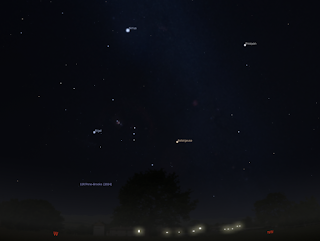The New Moon is Wednesday, May 8. Comet 12P Pons-Brooks is visible in binoculars and will progressively climb higher over the week heading for the iconic Orion constellation. Between 3 and 6 May the waning Moon joins the lineup of Saturn, Mars and Mercury. On the 4th there is a spectacular close approach of the Moon to Saturn, with a daytime occultation in the eastern states. On the 5th The Moon is close to Mars and on the 6th it is close to Mercury. On the 6th-8th the eta Aquariid meteor shower is visible in the morning sky.
The New Moon is Wednesday, May 8. The Moon is at perigee, when it is closest to Earth, on the 6th.
Evening
sky on Saturday, May 4 as seen from Adelaide at 18:27 ACST (60 minutes
after sunset, click to embiggen). Comet 12P is rising higher in the evening twilight.
While
the comet is a reasonable bright magnitude 4.7, it is still not too far
from the horizon. You will definitely need binoculars. Over the week the
comet will climb higher into darker skies and. Updated spotters charts are here.
Similar views will be seen from the rest of Australia at the equivalent local time (60 minutes after sunset).
Evening
sky on Thursday, May 9 as seen from Adelaide at 18:52 ACST (90
minutes after sunset, click to embiggen). Comet 12P is below Orion close to the star nu Eridanus in the constellation of the river.
While the comet is a modestly bright magnitude 5, despite now being visible when the sky is fully dark, you will still need binoculars. Over the week the comet will climb towards Orion and into darker skies, but becomes dimmer as it rises. Updated spotters charts are here.
Similar views will be seen from the rest of Australia at the equivalent local time (90 minutes after sunset).
Morning
sky on Saturday, May 4 as seen from Adelaide at 05:57ACST, (60 minutes before sunrise, click to embiggen). The Moon is very close to Saturn with Mars and Mercury below. The eastern states see a daytime occultation of Saturn in the morning.
Similar views will be seen from the rest of Australia at the equivalent local time (60 minutes before sunrise).
The Moon at 9:03 am AEST in Sydney on Saturday 4 May just as Saturn
disappears behind the Moon. The insets shows the telescope view of
Saturn going behind the Moon (left) and emerging from behind the Moon at
9:22 am AEST (right)
For detailed times and observing hints see the occultation page.
Morning
sky on Sunday, May 5 as seen from Adelaide at 05:59ACST, (60 minutes
before sunrise, click to embiggen). The Moon is very close to Mars with Saturn above and Mercury below.
Similar views will be seen from the rest of Australia at the equivalent local time (60 minutes before sunrise).
The north-eastern horizon as seen from Adelaide at 5:00 am ACST on 7 May, the
eta Aquariid radiant is marked with a starburst. Similar views will be
seen elsewhere in Australia at the equivalent local time (click to
embiggen).
The eta Aquariid meteor shower, which is produced by the debris from Halley’s Comet, will peak
on May 6 (strictly speaking May 5, 21UT).
Whole sky on Saturday, May 4 as seen from Adelaide at 18:56 ACST, 90 minutes after sunset (click
to embiggen). Orion is low in the north-west. Bright Sirius is still dominant in the north-western sky. Scorpius is rising in the East. Between the bright star
Canopus and the Southern Cross are a wealth of binocular objects to
discover. As the Moon wanes , the fainter clusters will be visible again.
Elsewhere
in Australia will see a similar view at the equivalent time (90 minutes after sunset).
Mercury climbs higher into the twilight. On the 6th the Moon is close to Mercury.
Venus is lost in the morning twilight.
Mars is rising in the morning twilight. On the 5th The Moon is close to Mars.
Jupiter is lost in the twilight sky.
Saturn climbs higher in the morning twilight. On the 4th there is a spectacular close approach of the Moon to Saturn, with a daytime occultation in the eastern states.
Labels: weekly sky













